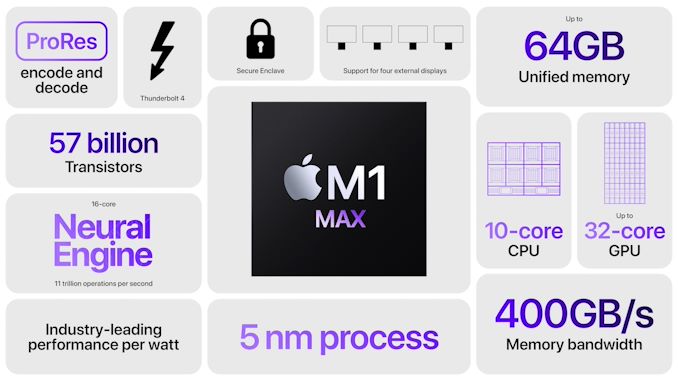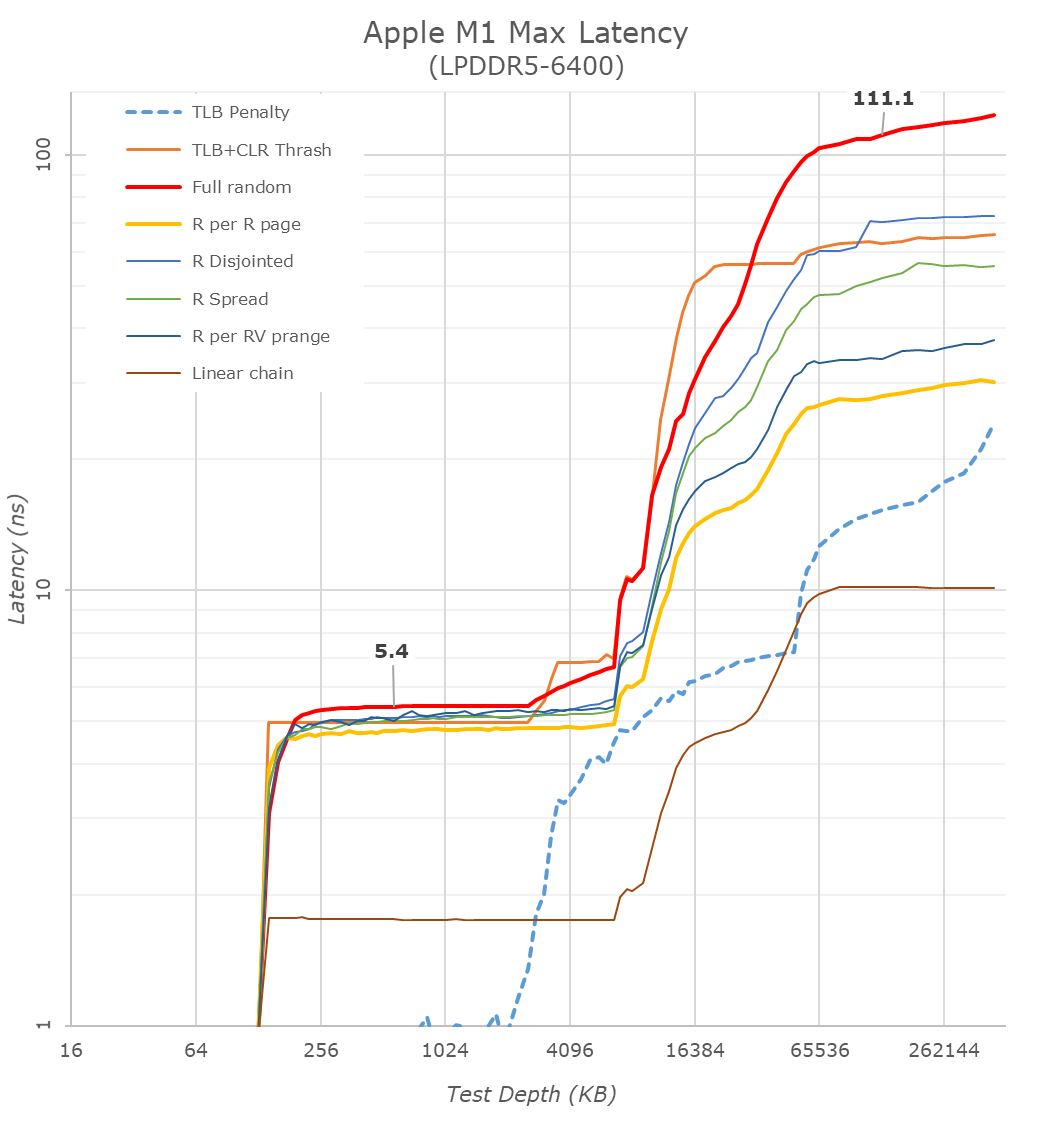Apple's M1 Pro, M1 Max SoCs Investigated: New Performance and Efficiency Heights
by Andrei Frumusanu on October 25, 2021 9:00 AM EST- Posted in
- Laptops
- Apple
- MacBook
- Apple M1 Pro
- Apple M1 Max
Huge Memory Bandwidth, but not for every Block
One highly intriguing aspect of the M1 Max, maybe less so for the M1 Pro, is the massive memory bandwidth that is available for the SoC.
Apple was keen to market their 400GB/s figure during the launch, but this number is so wild and out there that there’s just a lot of questions left open as to how the chip is able to take advantage of this kind of bandwidth, so it’s one of the first things to investigate.
Starting off with our memory latency tests, the new M1 Max changes system memory behaviour quite significantly compared to what we’ve seen on the M1. On the core and L2 side of things, there haven’t been any changes and we consequently don’t see much alterations in terms of the results – it’s still a 3.2GHz peak core with 128KB of L1D at 3 cycles load-load latencies, and a 12MB L2 cache.
Where things are quite different is when we enter the system cache, instead of 8MB, on the M1 Max it’s now 48MB large, and also a lot more noticeable in the latency graph. While being much larger, it’s also evidently slower than the M1 SLC – the exact figures here depend on access pattern, but even the linear chain access shows that data has to travel a longer distance than the M1 and corresponding A-chips.
DRAM latency, even though on paper is faster for the M1 Max in terms of frequency on bandwidth, goes up this generation. At a 128MB comparable test depth, the new chip is roughly 15ns slower. The larger SLCs, more complex chip fabric, as well as possible worse timings on the part of the new LPDDR5 memory all could add to the regression we’re seeing here. In practical terms, because the SLC is so much bigger this generation, workloads latencies should still be lower for the M1 Max due to the higher cache hit rates, so performance shouldn’t regress.
A lot of people in the HPC audience were extremely intrigued to see a chip with such massive bandwidth – not because they care about GPU or other offload engines of the SoC, but because the possibility of the CPUs being able to have access to such immense bandwidth, something that otherwise is only possible to achieve on larger server-class CPUs that cost a multitude of what the new MacBook Pros are sold at. It was also one of the first things I tested out – to see exactly just how much bandwidth the CPU cores have access to.
Unfortunately, the news here isn’t the best case-scenario that we hoped for, as the M1 Max isn’t able to fully saturate the SoC bandwidth from just the CPU side;
From a single core perspective, meaning from a single software thread, things are quite impressive for the chip, as it’s able to stress the memory fabric to up to 102GB/s. This is extremely impressive and outperforms any other design in the industry by multiple factors, we had already noted that the M1 chip was able to fully saturate its memory bandwidth with a single core and that the bottleneck had been on the DRAM itself. On the M1 Max, it seems that we’re hitting the limit of what a core can do – or more precisely, a limit to what the CPU cluster can do.
The little hump between 12MB and 64MB should be the SLC of 48MB in size, the reduction in BW at the 12MB figure signals that the core is somehow limited in bandwidth when evicting cache lines back to the upper memory system. Our test here consists of reading, modifying, and writing back cache lines, with a 1:1 R/W ratio.
Going from 1 core/threads to 2, what the system is actually doing is spreading the workload across the two performance clusters of the SoC, so both threads are on their own cluster and have full access to the 12MB of L2. The “hump” after 12MB reduces in size, ending earlier now at +24MB, which makes sense as the 48MB SLC is now shared amongst two cores. Bandwidth here increases to 186GB/s.
Adding a third thread there’s a bit of an imbalance across the clusters, DRAM bandwidth goes to 204GB/s, but a fourth thread lands us at 224GB/s and this appears to be the limit on the SoC fabric that the CPUs are able to achieve, as adding additional cores and threads beyond this point does not increase the bandwidth to DRAM at all. It’s only when the E-cores, which are in their own cluster, are added in, when the bandwidth is able to jump up again, to a maximum of 243GB/s.
While 243GB/s is massive, and overshadows any other design in the industry, it’s still quite far from the 409GB/s the chip is capable of. More importantly for the M1 Max, it’s only slightly higher than the 204GB/s limit of the M1 Pro, so from a CPU-only workload perspective, it doesn’t appear to make sense to get the Max if one is focused just on CPU bandwidth.
That begs the question, why does the M1 Max have such massive bandwidth? The GPU naturally comes to mind, however in my testing, I’ve had extreme trouble to find workloads that would stress the GPU sufficiently to take advantage of the available bandwidth. Granted, this is also an issue of lacking workloads, but for actual 3D rendering and benchmarks, I haven’t seen the GPU use more than 90GB/s (measured via system performance counters). While I’m sure there’s some productivity workload out there where the GPU is able to stretch its legs, we haven’t been able to identify them yet.
That leaves everything else which is on the SoC, media engine, NPU, and just workloads that would simply stress all parts of the chip at the same time. The new media engine on the M1 Pro and Max are now able to decode and encode ProRes RAW formats, the above clip is a 5K 12bit sample with a bitrate of 1.59Gbps, and the M1 Max is not only able to play it back in real-time, it’s able to do it at multiple times the speed, with seamless immediate seeking. Doing the same thing on my 5900X machine results in single-digit frames. The SoC DRAM bandwidth while seeking around was at around 40-50GB/s – I imagine that workloads that stress CPU, GPU, media engines all at the same time would be able to take advantage of the full system memory bandwidth, and allow the M1 Max to stretch its legs and differentiate itself more from the M1 Pro and other systems.













493 Comments
View All Comments
UnNameless - Wednesday, November 17, 2021 - link
Where did you get the 3000 writes number from?I know for a fact that I did >1000 full drive writes on my 1TB SSD in my iMac Pro and it barely hit 86% SSD lifetime! So I wrote more than 1PB of data and still got 86% life in it!
coolfactor - Tuesday, October 26, 2021 - link
Hey folks, listen to turbine! He really knows what he's talking about! I mean, he's never used a Mac, or he'd know better, but hey, listen to him anyway! He can't get the OS names correct (it's macOS and iOS, with a small "i"), but hey, he's making an important point! So important! More market share obviously means better! Yah? So that $2.00 cheeseburger from McDonalds is abviously the best because it's low-cost and everywhere! Yah, that's what matters, after all!Daniel Egger - Wednesday, October 27, 2021 - link
Don't be ridiculous. The 16" MBP with the M1 Max costs less than what I have paid for my TiBook way back when and that's without inflation considered. Oh, and back then I was just a student, tired of his Compaq Armada 1750 aka "the brick".xeridea - Tuesday, October 26, 2021 - link
Developers optimize for PC, knowing that Mac has virtually no marketshare for gamers. There are decent APUs and midrange gaming laptops that aren't hot and heavy.Altirix - Monday, October 25, 2021 - link
actually could be unlikely, Apple are trying to kill of any open-source low-level graphics API in favour of their own API metal. look at the smaller devs who are going to be less likely to go out their way to rewrite their engines to support metal especially when they also need to buy the hardware to test it on. prior to that is if macos can run it cool, if it can well that's a shame. big devs follow the money so the rest will be up to apple handing out engineers or there's enough people gaming on macphotovirus - Monday, October 25, 2021 - link
Apple doesn't try to kill Vulkan, it's just they don't care. They've eaten OpenGL problems for years and they've had enough, thus no respect for open-source. What they want is a fast modern cross-platform framework, and that's Metal. It's tightly controlled, so it's easy to implement any new hardware feature into it.Since there's a quite a number of iPads and Macs with M1, I think publishers will invest into Metal optimisation.
bernstein - Monday, October 25, 2021 - link
Metal isn‘t cross-platform. ios & macos are the same os with a different „skin“ (ui/lifecycle model).techconc - Monday, October 25, 2021 - link
@bernstein... That's like saying Andorid and Linux aren't different platforms... you know because they share some common ground. From a developer perspective, iOS and MacOS are different platforms. Yes, there is much similarity, but there are also differences.tunsten2k - Monday, October 25, 2021 - link
No, it's like saying Android and ChromeOS aren't different platforms, and generally, that would be a reasonable statement. Regardless, "cross platform" doesn't mean "across 2 proprietary platforms, only one of which is non-mobile and makes up only 16% of the non-mobile market". Get a grip :)Hrunga_Zmuda - Monday, October 25, 2021 - link
No, they are not the same OS. They have the same base, but they are quite different in many ways. But Metal isn't one of those differences. Metal is powerful and any developer who wants to break into the Mac world will be going there in the future.